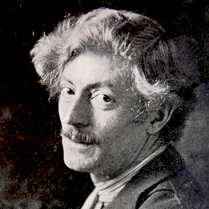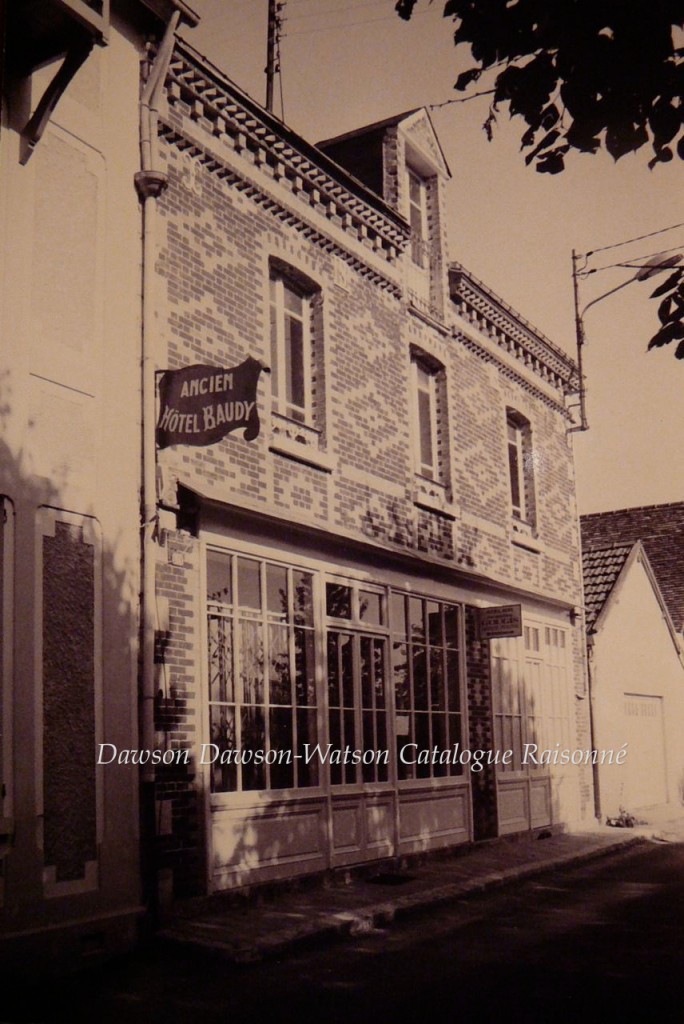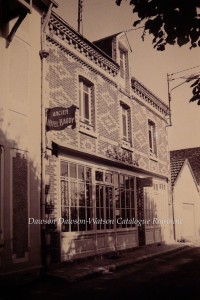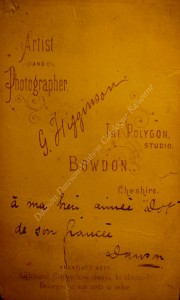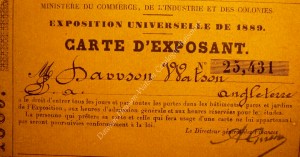The 1881 England Census listed Dawson-Watson as an “art student.” During the early 1880s, he assisted his father with various commissions, learned watercolor techniques from his uncle, Thomas J. Watson (1847–1912), and studied drawing and painting with the American-born British painter, Mark Fisher (1841–1923).
- 1879-80 – Shortly after finishing grammar school, Dawson-Watson was invited to visit his father’s friend, the art critic and writer Fred Broughton, who lived in Buckingham Street, Strand. During his six-week stay, Dawson-Watson accompanied Broughton to theatrical productions and frequently assisted him in writing reviews. In addition to experiencing the theatre, Dawson-Watson had the opportunity to meet some of the leading matinee idols of the day, Kyrle Bellew, Johnston Forbes-Robertson and his brother, Ian Robertson.
- 1880 – Dawson-Watson returned home to the family’s new residence, Longsden, located at Marylebone 19, Marlborough Hill, in London. Longsden was the former home of the English figure painter, Edwin Longsden Long. During the next two years, Dawson-Watson painted tiles for the interior decorating department of Howell James and Co., a firm of jewelers and silversmiths.
- 1881-82 – In October 1881, the Savoy Theatre opened its doors in the Strand. Richard D’Oyly Carte built the Savoy as a showcase for the popular comic operas of Gilbert and Sullivan. Dawson-Watson, who attended productions at the theatre later recalled that it was the first to have a real tapestry curtain and the first to adopt the “queue” – the French manner of standing in line in twos for admission.
Dawson-Watson was seventeen years old when he and his father, John Dawson Watson, left London. For a period of six months, Dawson-Watson traveled throughout Northern England, assisting his father with his portrait commissions. During this period, they visited Conwy, Wales, where John Dawson Watson executed a series of murals at the Castle Hotel. From there they moved to Betws-y-Coed where Dawson-Watson learned the process of making mezzotints from the artist Joseph Knight.
- 1882-83 – Dawson-Watson began studying with the painter, Mark Fisher (a friend of his father’s) at Steyning, in Sussex. He stayed there for one year before following Fisher to Bourne End, Buckinghamshire, where he continued his studies for six months. Recalling his training under Fisher, Dawson-Watson said:
He made me draw in hard conté crayon which was practically impossible to erase. His [Fisher’s] pictures were almost invariably of sheep and cattle, so I set to work drawing those in repose and in action. I wore a tight-fitting leather belt with two iron bars attached to it with turned-up ends, which stuck straight out in front. On these rested a board, on which was a sheet of drawing paper, the upper corner of which I held in my left hand, leaving my right hand free to draw with. Such a contraption made me a walking easel! I followed the beasts around the pasture, making anatomical drawings. At other times I was drawing trees, branches, grass and rocks. After a few months of this I was allowed to paint.
During his evenings with Fisher and his wife, Dawson-Watson learned that Fisher was a pupil of the painter, George Inness, and a friend of the wood-engraver Timothy Cole. It was during this period that Inness contacted Fisher and informed him that he was coming down from London to see him. Dawson-Watson was introduced to Inness during his visit with Fisher.
- 1884-86 – Between 1884 and 1886 Dawson-Watson joined the Llanrwst Fusilers Infantry Regiment, near Betws-y-Coed. During this period, he spent his time playing soccer and painting at every available opportunity.
Dawson-Watson in his Early Twenties
(Dawson Dawson-Watson family archives)
- 1886 – Seeking to create his own artistic identity, Dawson-Watson decided to move to France; he later remarked: “I left England to escape being a weak copy of my father!” With a £50 monthly stipend from his patron, the brewer Henry Boddington, he sailed from Southampton to Saint-Malo, France. He then took a train to Quimperlé, where he stayed at the Hotel Destais for the next four months.
Dawson Dawson-Watson, La porte de l’Hôpital, Quimperlé, 1886, Pencil on paper, 10 x 6 in. (25.4 x 15.2 cm)
(Dawson Dawson-Watson family archives)
- 1886 – At the suggestion of an artist friend, Dawson-Watson decided to leave Quimperlé and move to Paris to further his studies. He first visited the Académie Julian. At that time the Académie Julian had four studios and four teachers: Bouguereau, Boulanger, Doucet and Tony Robert-Fleury. Dawson-Watson recalls that the studios were packed solid with students, about one hundred to a room.
After his visit to the Académie Julian, Dawson-Watson decided to train with the academic painter, Carolus-Duran (1837–1917), whose roster of American pupils included John Singer Sargent. Dawson-Watson believed that he would improve his drawing and method of handling color under Carolus. As recounted by Dawson-Watson during his first visit to Carolus-Duran’s studio:
When we entered he was seated on a footstool playing a guitar while a circle of ladies sat enraptured. Becoming aware of our presence, he immediately put guitar and ladies into the background and came forward to greet us. He was charm itself and expressed himself to the effect that he would be delighted to have me in his class. He was wearing the same type of ruffled shirt which is in one of the features of Sargent’s portrait of him.
Carolus insisted that his students, “cherchez donc la caractere”, recalled Dawson-Watson, and to pay great attention to color, good harmony and “le demi-teint”. Carolus criticized twice a week, once for the drawing and then for the painting.
Dawson-Watson studied with Carolus through the winter of 1886. He spent the mornings with Carolus and then in the afternoons he studied at the Académie Colarossi. At the end of the winter of 1886 Dawson-Watson returned to England.
- 1887 – After spending the summer in England, Dawson-Watson returned to Paris in the fall and began studying with Raphael Collin (1850–1916), who he described as a “splendid teacher.” Dawson-Watson recalled that he insisted on good drawing and in painting never let up on the word envelope: “Ca manque d’enveloppe” or “ca n’est-pas enveloppe,” meaning the painting was flat.
- 1888 – Known address for Dawson-Watson – Latin Quarter, Paris: corner of Blvd Mont Parnasse and Blvd d’Enfer (Blvd Raspail)
In 1888, Dawson-Watson began working on a five by eight canvas, Sous les pommiers (The Orchard), (unlocated) for the Salon des Indépendants March 22 –May 3, 1888. As he explained in his memoir, he had been struggling with the “color composition” of the work and approached Collin with his concerns. Collin replied, “If there is any small study of any of my figures painted in the open air that will help you, pray take it and use it.” Elated with this offer, Dawson-Watson borrowed one of Collin’s studies, using it as inspiration for his salon canvas.
Dawson-Watson in the Paris studio of Simon Harmon Vedder with his 1888 Salon painting, Sous les pommiers (The Orchard).
(Dawson Dawson-Watson family archives)
(Dawson Dawson-Watson family archives)
Dawson-Watson (second from the left) being consoled by friends after a prankster threw paint on Sous les pommiers.
(Dawson Dawson-Watson family archives)
Dawson-Watson (center) and artist friends.
(Dawson Dawson-Watson family archives)
- 1888 – At the invitation of John Leslie Breck, a fellow artist, Dawson-Watson made his first visit to Giverny, the recently established art colony located on the banks of the Seine about forty-five miles northwest of Paris. His first residence in the village was the Hôtel Baudy owned by Madame and Monsieur Baudy. He registered there on May 12, 1888 and was active in the colony over the next five years. During these years, he painted some of his best known scenes of rural life, notably Gathering Firewood and Harvest Time.
Among the small group of artists who resided in Giverny when Dawson-Watson first arrived were the Americans Breck, Theodore Wendel, Henry Fitch Taylor, Willard Metcalf, Theodore Robinson, and the Canadian William Blaire Bruce. In his memoir, Dawson-Watson recounted, “I was the first outsider to become an insider.”
The impressionist painter, Claude Monet, lived in Giverny at the time Dawson-Watson stayed there. Dawson-Watson recalled:
I had a nodding ‘time o’ day’ acquaintance with him and occasionally saw him out painting in the fields or on the river Epte, but I never made an attempt to get close enough to see what he was doing. Others that had no respect for privacy, did so —total strangers—and got cussed out for their pains and it served ‘em right.
Hôtel Baudy, 81 rue Claude Monet, Giverny, France. Studio for Dawson-Watson as well as other resident artists.
(Dawson-Watson family photo)
Interior view of the Hôtel Baudy with two unidentified women. Dawson-Watson’s Haystacks, Giverny, 1888 is hanging directly above the woman seated at the table.
(Dawson Dawson-Watson family archives)
Shortly after his arrival in Giverny, Dawson-Watson met the artist Emma Richardson Cherry (1859–1954) and her traveling companion Mary Hoyt Sellar (1864–1952). After a two week courtship, Dawson-Watson and Mary Hoyt Sellar were married at the British Embassy in Paris on May 30, 1888. Returning to Giverny, they stayed at the Baudy until September 15, 1888.
During this time, Dawson-Watson met the artist John LaFarge (1835–1910) a painter, muralist, and decorative artist from New York who was in Giverny visiting his sister-in-law, the impressionist painter Lilla Cabot Perry (1848–1943). The two men became friendly and LaFarge returned to New York with fourteen of Dawson-Watson’s paintings to sell.
Studio portrait photograph of Dawson Dawson-Watson
(Dawson Dawson-Watson family archives)
Reverse side of photograph shown above
Affectionate note to Dot from Dawson-Watson.
(Dawson Dawson-Watson family archives)
Dawson Dawson-Watson in his Paris studio ca. 1888.
(Dawson Dawson-Watson family archives)
Mary Hoyt (Dot) Dawson-Watson with her pet rabbit in Dawson-Watson’s Paris studio ca. 1888.
Dawson-Watson affectionately nicknamed his wife “Dot,” due to her petite stature.
(Dawson Dawson-Watson family archives)
- 1889 – The fourth Exposition Universelle de 1889 was held in Paris from May 6 – November 6. Dawson-Watson exhibited a painting titled Les Gerbes de Ble (haystacks) at the Exposition (unlocated).
(Dawson Dawson-Watson family archives)
Recto and verso of Dawson-Watson’s official exhibitor card for the 1889 Exposition Universelle.
(Dawson Dawson-Watson family archives)
- 1889 – In August of 1889 Dawson-Watson and his wife returned to London. After a brief stay in London, he received a letter from his father asking him to come to Conwy, Wales to help him finish a series of murals. Upon completing the project, Dawson-Watson remained in Conwy, painting and selling his impressionist-inspired work to tourists.
It was during this trip to Conwy that his father introduced him to a wealthy cotton spinner, Mr. Haworth of Haworth Cotton, from Rawtenstell in Lancashire. Mr. Haworth became Dawson-Watson’s patron. In exchange for a monthly stipend of £50, Dawson-Watson sent him four paintings a month for the next two years.
1881 England Census, Ancestry.com (online database), accessed August 14, 2014
“Glory of the Morning,” Pioneer Magazine 7: A Blazer of New Trails, April 1927.
Dawson Dawson-Watson, “Things Remembered,” manuscript memoir, Dawson-Watson family archives.

